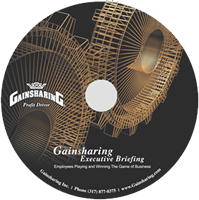One of my “pet peeves” is the way most companies “pull the juice” or the excitement out of work for most people.
We do everything possible to make their jobs a boring, tedious drag.
First of all, their pay is set.
If they’re salaried, it’s set from the beginning. If they’re hourly, their pay is largely set too, plus or minus some overtime. So whether things go well or not, the outcome’s the same for them.
Then we do an awful job of giving them feedback.
It’s like the joke about mushroom management.
Keep’em in the dark. Cover them with fertilizer, and hope that something good happens!
Well, I believe work needs to be exciting and that we should actively structure our companies to make it so.
We need to make work more like a game.
A game that
– people are excited about playing,
– pulls them in, and
– enables them to get much of what they need out of life from their work.
How Do We Make Work Like a Game?
There are three essentials to making something like a game:
(1) Trying to do something
(2) Feedback
(3) Something that is important to the person.
Discussing making something like a game always makes me think of Las Vegas.
Gambling is something that I really don’t know a lot about.
Well, I was on a business trip in Las Vegas, waiting at the hotel for the transport bus that was going to take us to where our business meeting was. I began looking at the slot machines and said to myself, “This is silly. I’m not against gambling. Why don’t I try to see what all the excitement’s about.”
So I get a quarter out of my pocket and approach the slot machine.
Where do you put the money in? I thought there was suppose to be a handle that I pulled or something.
Step One.
So Here I am, trying to make the machine work. That’s the first step of making something like a game. You’re trying to do something or make something happen.
Then the little wheels with the fruit on them started spinning. Bling, Bling. Little lights flash. All my energy was focused on this machine. We could have had an earthquake right then and I don’t think it would have distracted me.
The first wheel stopped on a cherry, the second on a cherry too. “I’m going to win!! I’m going to win!!” Then the last one ends on an orange and I lose. Immediately I start reaching for another quarter . . . .
Step Two.
So what’ve they done to me? They have the first essential: trying to make something happen. And then they pull me in with all the feedback. Lights, sound, motion . . . .
That’s the second step in making something like a game: giving them feedback as they try to make something happen.
Having something a person is trying to do (Step 1), and giving feedback (Step 2) gives you more than 80% of what you need to make something like a game.
I wasn’t really interested in the money. I wanted the “bragging rights” to tease the people I had traveled to Vegas with . . . that I, the know-nothing beginner, had won more than they did with all their strategies and experience.
Step Three.
It was about the fun of ribbing them and teasing them on the trip home. But this provided the last element: (Step Three) having something that is important to the person tied to winning the game.
So these are the three elements we want to get going in your company with Gainsharing.
How Gainsharing Makes Work Like a Game.
(1) First, we are going to build a plan that would have us on track to hit a bonus of $200 per person (on average) for the month.
(2) Then we’re going to break that plan down, so each area and each person can see what they need to do . . . this week, today, on this shift . . . to be carrying their weight towards that goal.
Then we are going to give them “in their face” feedback about whether they are “carrying their weight” to hit the goals.
(3) What happens matters to them. That is, they’ve got “skin in the game.” They definitely don’t want to be the area that keeps the Company from hitting the overall goal and getting the bonus. They want the money (of course) but there’s much more to it than that. The social consequences and visibility provide powerful influence and put teeth into the outcomes.
So this gives us the three elements:
(1) Trying to make something happen
(2) “in their face” feedback and
(3) something that is important to them.
Your homework:
(1) Do your people know what they need to do specifically, today, to beat the company’s profit goals and to be on track to get a bonus this month?
If they don’t, do you think it would make a difference in how things turn out if they did know?
What would your Company be like if everyone knew what they were suppose to be to be doing to pull their weight, and where they stood on that?
What goals do you have that would clarify this for them? You MUST be specific!
(2) Do your people get feedback about where they are on the key “scores” they need to achieve to hit the profit and bonus goals?
How could you let them know more about this than they currently know?
Select a group and ask what info would be helpful that they’re currently not getting.
Often I find that the info is available, and others “think they know,” but actually the people who could use the info, aren’t getting feedback in a useful way.
(3) Lastly, is something important to them tied to hitting these goals?
What can you do to answer the “What’s in it for me?” question they will have eventually, if not right away?
How could you tie acknowledgement or other rewards to hitting their goals?
So How Do You Make This Happen At Your Company?
If you need to make “work into a game” in your company, Gainsharing is the most powerful, proven tool to do this.
It’s a “magic dust” that many Gainsharing companies keep secret because it works so well for them.
It makes sure the follow-through, discipline, and focus is there, week after week.
Tim Gase, President of Peerless Saw in Groveport, Ohio, once told me that he likes the way his Gainsharing System “forces his managers to get together once a week to look at what happened and what was suppose to happen, whether they had time for it, or feel like it or not.”


